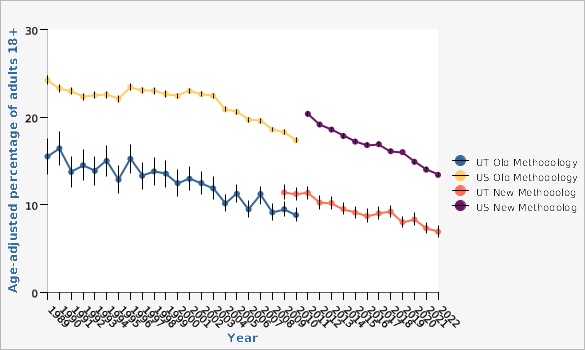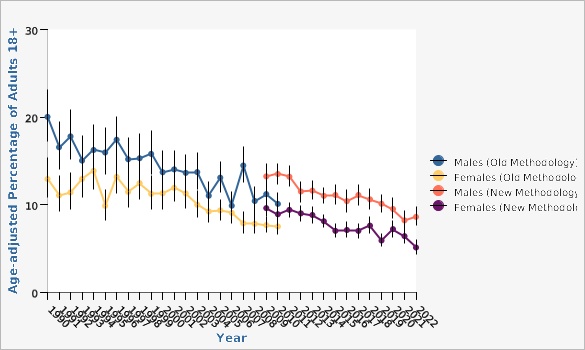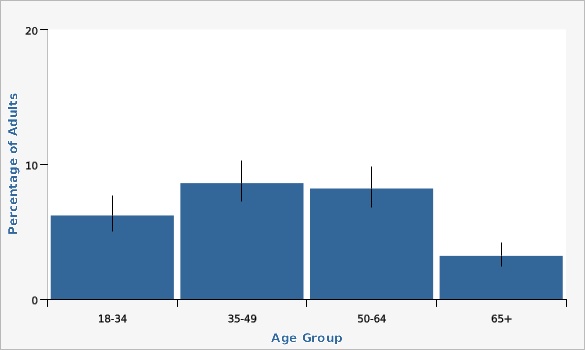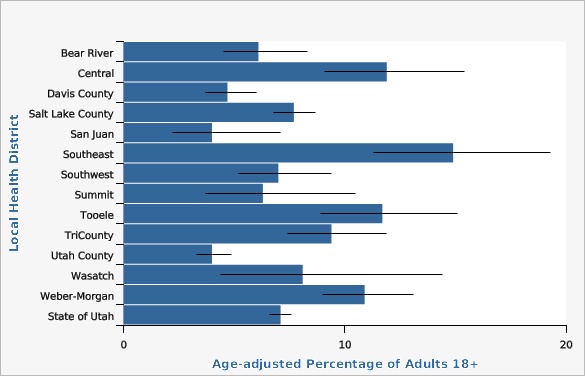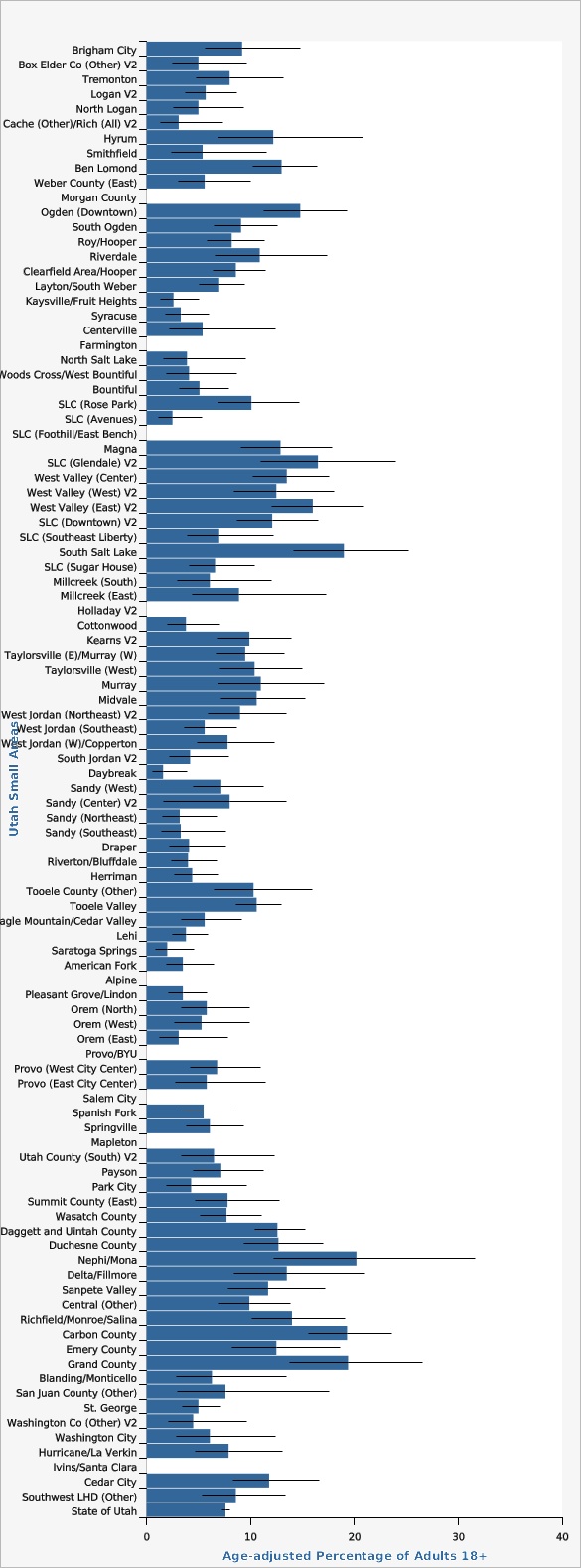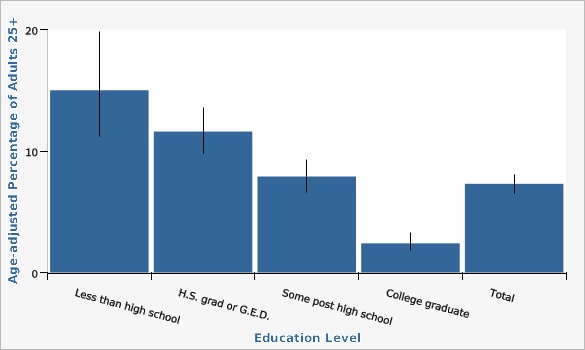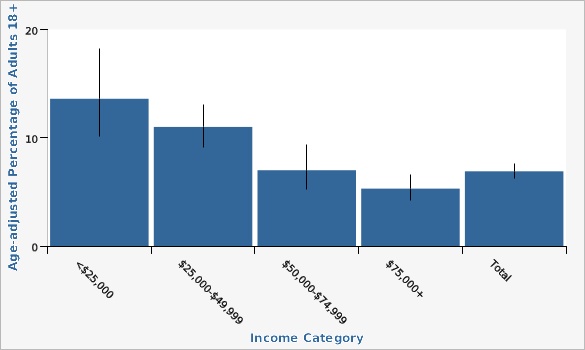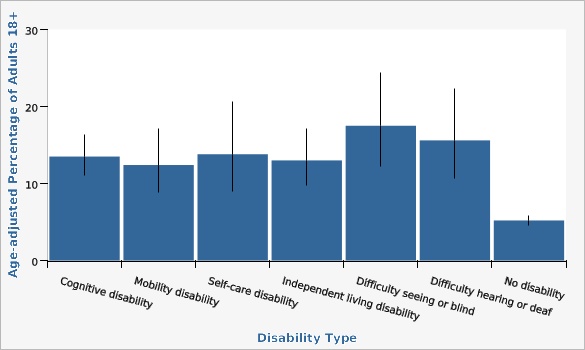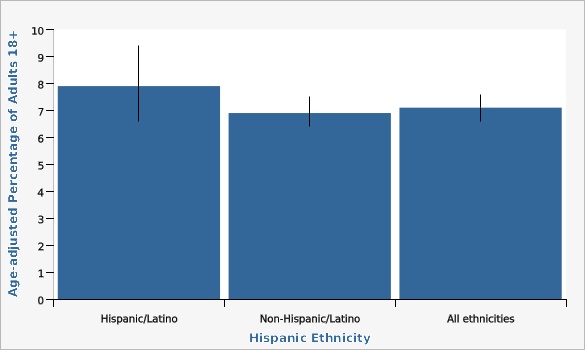Complete Health Indicator Report of Smoking Among Adults
Definition
Current smoking: Percentage of adults aged 18 years and older who smoke cigarettes every day or some days.[[br]] [[br]] Quit attempt: Percentage of current smokers aged 18 years and older who reported that they stopped smoking for one day or longer in the past 12 months because they were trying to quit.Numerator
Current smoking: Number of adults aged 18 years and older who have smoked at least 100 cigarettes in their life time and who now report smoking cigarettes every day or some days.[[br]] [[br]] Quit attempt: Number of survey respondents who reported being current smokers and stopping smoking for one day or longer in the past 12 months because they were trying to quit.Denominator
Current smokers: Number of adults aged 18 years and older.[[br]] [[br]] Quit attempt: Number of survey respondents who reported being current cigarette smokers.Data Interpretation Issues
The Behavioral Risk Factor Surveillance System (BRFSS) survey is conducted with a representative sample of non-institutionalized Utah adults living in households with a landline telephone. In 2010, the BRFSS added cell phone interviews to the survey protocol and introduced a new weighting methodology that better represents populations of low socioeconomic status. More details about these changes can be found at: [https://ibis.health.utah.gov/pdf/opha/resource/brfss/RakingImpact2011.pdf]. Due to these changes survey results from the years before 2010 are not comparable to results observed in 2010 or later. The 2010 estimated adult smoking rate was higher compared to rates from previous years that were based on post-stratification by age, sex, and local health district. As with all telephone surveys, data may be subject to error as resulting from non-coverage (e.g., lower telephone coverage among some low SES populations), non-response (e.g., refusal to participate in the survey or answer specific questions), or measurement (e.g. social desirability or recall bias). Interviewer training and monitoring and strict adherence to good survey research protocols reduce errors from these sources.Why Is This Important?
Tobacco use remains the leading preventable cause of death and disease in the United States. In Utah, smoking claims more than 1,300 lives each year. It causes or worsens nearly every chronic condition and contributes to the primary causes of death in Utah including heart disease, respiratory disease, and cancer. Smoking increases the risk for cancer of the lungs, larynx, esophagus, mouth, and bladder and contributes to cancer of the cervix, pancreas, and kidneys. Exposure to secondhand smoke increases the risk of heart disease and lung cancer among nonsmokers.Healthy People Objective TU-1.1:
Reduce cigarette smoking by adultsU.S. Target: 12.0 percent
State Target: 9.0 percent
Other Objectives
Utah's 42 Community Health Indicators[[br]] CSTE Chronic Disease IndicatorsHow Are We Doing?
The Utah adult smoking rate has decreased significantly since the Utah Department of Health Tobacco Prevention and Control Program started receiving Master Settlement Agreement funds in 2000. People with low household income and fewer years of formal education report higher rates of tobacco use than the general population. Approximately 70% of Utah smokers intend to quit within the next year. Comprehensive and free tobacco cessation services help Utah smokers quit successfully and ensure declines in tobacco use rates across population groups.How Do We Compare With the U.S.?
In 2021, the Utah adult smoking rate was 7.3% compared to the national rate of 16.0% (2019). (Rates are age-adjusted to the U.S. 2000 standard population.)What Is Being Done?
The Tobacco Prevention and Control Program (TPCP) at the Utah Department of Health and its partners use comprehensive programs to prevent young people from starting to use tobacco, help tobacco users quit, promote tobacco-free environments, and reduce tobacco-related disparities. These programs include an extensive anti-tobacco marketing campaign, free and confidential tobacco cessation services, school- and community-based prevention programs, and efforts to improve tobacco-free policies. These policies support tobacco-free norms and protect nonsmokers from secondhand smoke. The marketing campaign uses television, radio, billboard, print, and online media to reach youth, adults, pregnant women, racial and ethnic minorities, and rural populations with anti-tobacco messages. The goals of the campaign are to counter tobacco industry promotions, inform Utahns about quitting services, and support local tobacco control efforts. Quitting services available to Utahns are accessible through the Utah tobacco cessation web site, [http://www.waytoquit.org], and include a toll-free Tobacco Quitline (1-800-QUIT-NOW), individual services that allow tobacco users to choose from a combination of quit medications, e-mail, chat, or text messages, and print materials, and a web-based tobacco cessation program. The TPCP also partners with community health clinics to offer counseling services for uninsured or under-insured tobacco users. Efforts to protect nonsmokers from secondhand smoke focus on strengthening tobacco-free policies in apartment complexes, workplaces, schools, and outdoor venues frequented by children.Available Services
The Utah Tobacco Quitline and Utah's online quitting program offer assistance in quitting tobacco use to Utah adults and teens. For services and information call the Utah Tobacco Quitline at 1-800-QUIT-NOW or visit Utah's tobacco cessation web site at [http://www.waytoquit.org].Health Program Information
To receive more information about tobacco prevention and control programs in Utah, call the Tobacco Free Resource Line at 1-877-220-3466. For information on quitting tobacco use, visit [http://www.waytoquit.org] or call the Utah Tobacco Quitline at 1-800-QUIT-NOW.Related Indicators
Relevant Population Characteristics
Cigarette smoking is more common among persons with lower levels of formal education, those in lower income groups, and people with mental health conditions or disabilities.Related Relevant Population Characteristics Indicators:
- Utah Population Characteristics: Age Distribution of the Population
- Smoking Among Adolescents
- Utah Population Characteristics: Education Level in the Population
- Fair/poor health
- Utah Population Characteristics: Household Income
- Lung Cancer Incidence
- Lung Cancer Deaths
- Utah Population Characteristics: Per Capita Income
Related Health Care System Factors Indicators:
Risk Factors
Cigarette smoking is more common among persons with lower levels of formal education and among those in lower income groups.Related Risk Factors Indicators:
Health Status Outcomes
Smoking increases the risk for chronic lung disease, coronary heart disease, and stroke, as well as cancer of the lungs, larynx, esophagus, mouth, and bladder.Related Health Status Outcomes Indicators:
Graphical Data Views
A new weighting methodology that better represents populations of low socioeconomic status and added cell phone interviews produced a higher estimated smoking rate for Utah adults compared to previous estimates that were based on post-stratification by age, sex, and local health district.
| BRFSS Utah vs. U.S. | Year | Age-adjusted percentage of adults 18+ | Lower Limit | Upper Limit | ||
|---|---|---|---|---|---|---|
Record Count: 66 | ||||||
| UT Old Methodology | 1989 | 15.5% | 13.5% | 17.5% | ||
| UT Old Methodology | 1990 | 16.4% | 14.5% | 18.3% | ||
| UT Old Methodology | 1991 | 13.7% | 12.0% | 15.5% | ||
| UT Old Methodology | 1992 | 14.5% | 12.7% | 16.3% | ||
| UT Old Methodology | 1993 | 13.9% | 12.2% | 15.5% | ||
| UT Old Methodology | 1994 | 15.0% | 13.2% | 16.8% | ||
| UT Old Methodology | 1995 | 12.8% | 11.2% | 14.5% | ||
| UT Old Methodology | 1996 | 15.2% | 13.6% | 16.8% | ||
| UT Old Methodology | 1997 | 13.3% | 11.7% | 14.9% | ||
| UT Old Methodology | 1998 | 13.8% | 12.2% | 15.4% | ||
| UT Old Methodology | 1999 | 13.5% | 12.0% | 15.1% | ||
| UT Old Methodology | 2000 | 12.5% | 10.9% | 14.0% | ||
| UT Old Methodology | 2001 | 13.0% | 11.6% | 14.3% | ||
| UT Old Methodology | 2002 | 12.5% | 11.1% | 13.8% | ||
| UT Old Methodology | 2003 | 11.8% | 10.5% | 13.2% | ||
| UT Old Methodology | 2004 | 10.1% | 9.2% | 11.2% | ||
| UT Old Methodology | 2005 | 11.2% | 10.2% | 12.4% | ||
| UT Old Methodology | 2006 | 9.5% | 8.5% | 10.5% | ||
| UT Old Methodology | 2007 | 11.2% | 10.1% | 12.0% | ||
| UT Old Methodology | 2008 | 9.1% | 8.2% | 10.2% | ||
| UT Old Methodology | 2009 | 9.5% | 8.7% | 10.3% | ||
| UT Old Methodology | 2010 | 8.8% | 8.1% | 9.6% | ||
| US Old Methodology | 1989 | 24.2% | 23.7% | 24.7% | ||
| US Old Methodology | 1990 | 23.3% | 22.8% | 23.8% | ||
| US Old Methodology | 1991 | 23.0% | 22.5% | 23.4% | ||
| US Old Methodology | 1992 | 22.3% | 21.9% | 22.7% | ||
| US Old Methodology | 1993 | 22.5% | 22.1% | 22.9% | ||
| US Old Methodology | 1994 | 22.6% | 22.2% | 23.0% | ||
| US Old Methodology | 1995 | 22.1% | 21.7% | 22.5% | ||
| US Old Methodology | 1996 | 23.4% | 23.1% | 23.8% | ||
| US Old Methodology | 1997 | 23.1% | 22.7% | 23.4% | ||
| US Old Methodology | 1998 | 23.0% | 22.6% | 23.3% | ||
| US Old Methodology | 1999 | 22.6% | 22.3% | 23.0% | ||
| US Old Methodology | 2000 | 22.4% | 22.1% | 22.7% | ||
| US Old Methodology | 2001 | 23.0% | 22.7% | 23.3% | ||
| US Old Methodology | 2002 | 22.6% | 22.3% | 22.9% | ||
| US Old Methodology | 2003 | 22.4% | 22.1% | 22.7% | ||
| US Old Methodology | 2004 | 20.9% | 20.6% | 21.2% | ||
| US Old Methodology | 2005 | 20.6% | 20.3% | 20.9% | ||
| US Old Methodology | 2006 | 19.7% | 19.4% | 20.0% | ||
| US Old Methodology | 2007 | 19.6% | 19.3% | 19.8% | ||
| US Old Methodology | 2008 | 18.6% | 18.3% | 18.8% | ||
| US Old Methodology | 2009 | 18.3% | 18.0% | 18.5% | ||
| US Old Methodology | 2010 | 17.3% | 17.1% | 17.6% | ||
| UT New Methodology | 2009 | 11.4% | 10.6% | 12.3% | ||
| UT New Methodology | 2010 | 11.2% | 10.5% | 12.0% | ||
| UT New Methodology | 2011 | 11.3% | 10.6% | 12.1% | ||
| UT New Methodology | 2012 | 10.2% | 9.5% | 11.0% | ||
| UT New Methodology | 2013 | 10.2% | 9.5% | 10.9% | ||
| UT New Methodology | 2014 | 9.5% | 8.9% | 10.2% | ||
| UT New Methodology | 2015 | 9.1% | 8.4% | 9.8% | ||
| UT New Methodology | 2016 | 8.7% | 8.0% | 9.6% | ||
| UT New Methodology | 2017 | 9.0% | 8.3% | 9.8% | ||
| UT New Methodology | 2018 | 9.2% | 8.5% | 9.9% | ||
| UT New Methodology | 2019 | 8.0% | 7.4% | 8.7% | ||
| UT New Methodology | 2020 | 8.3% | 7.6% | 9.1% | ||
| UT New Methodology | 2021 | 7.3% | 6.7% | 8.0% | ||
| US New Methodology | 2011 | 20.4% | 20.1% | 20.6% | ||
| US New Methodology | 2012 | 19.2% | 18.9% | 19.4% | ||
| US New Methodology | 2013 | 18.6% | 18.3% | 18.8% | ||
| US New Methodology | 2014 | 17.8% | 17.6% | 18.1% | ||
| US New Methodology | 2015 | 17.2% | 17.0% | 17.4% | ||
| US New Methodology | 2016 | 16.8% | 16.6% | 17.1% | ||
| US New Methodology | 2017 | 16.9% | 16.7% | 17.2% | ||
| US New Methodology | 2018 | 16.1% | 15.9% | 16.3% | ||
| US New Methodology | 2019 | 16.0% | ||||
Data Notes
Age-adjusted to U.S. 2000 population. Note: At the time of this update, the BRFSS U.S. dataset did not include an age variable but did include five age categories up to age 80+ (vs. the typical weighting scheme that includes 85+). Comparisons with both weighting schemes were compared using Utah data, and the difference was about 1/100 of a percentage point.Data Sources
- The Utah Department of Health and Human Services Behavioral Risk Factor Surveillance System (BRFSS)
- Behavioral Risk Factor Surveillance System Survey Data, US Department of Health and Human Services Centers for Disease Control and Prevention (CDC).
A new weighting methodology that better represents populations of low socioeconomic status and added cell phone interviews produced a higher estimated smoking rate for Utah adults compared to previous estimates that were based on post-stratification by age, sex, and local health district.
| Males vs. Females (BRFSS Old vs. New Methodology) | Year | Age-adjusted Percentage of Adults 18+ | Lower Limit | Upper Limit | ||
|---|---|---|---|---|---|---|
Record Count: 68 | ||||||
| Males (Old Methodology) | 1990 | 20.0% | 17.2% | 23.2% | ||
| Males (Old Methodology) | 1991 | 16.6% | 14.0% | 19.5% | ||
| Males (Old Methodology) | 1992 | 17.8% | 15.1% | 20.8% | ||
| Males (Old Methodology) | 1993 | 15.0% | 12.5% | 17.9% | ||
| Males (Old Methodology) | 1994 | 16.2% | 13.7% | 19.2% | ||
| Males (Old Methodology) | 1995 | 16.0% | 13.5% | 18.8% | ||
| Males (Old Methodology) | 1996 | 17.4% | 15.0% | 20.1% | ||
| Males (Old Methodology) | 1997 | 15.2% | 13.0% | 17.6% | ||
| Males (Old Methodology) | 1998 | 15.3% | 12.9% | 18.1% | ||
| Males (Old Methodology) | 1999 | 15.8% | 13.5% | 18.4% | ||
| Males (Old Methodology) | 2000 | 13.7% | 11.6% | 16.2% | ||
| Males (Old Methodology) | 2001 | 14.0% | 12.1% | 16.2% | ||
| Males (Old Methodology) | 2002 | 13.6% | 11.8% | 15.7% | ||
| Males (Old Methodology) | 2003 | 13.7% | 11.7% | 16.0% | ||
| Males (Old Methodology) | 2004 | 11.0% | 9.6% | 12.6% | ||
| Males (Old Methodology) | 2005 | 13.1% | 11.4% | 14.9% | ||
| Males (Old Methodology) | 2006 | 9.9% | 8.4% | 11.5% | ||
| Males (Old Methodology) | 2007 | 14.5% | 12.6% | 16.6% | ||
| Males (Old Methodology) | 2008 | 10.4% | 9.0% | 12.0% | ||
| Males (Old Methodology) | 2009 | 11.2% | 10.0% | 12.6% | ||
| Males (Old Methodology) | 2010 | 10.1% | 9.0% | 11.3% | ||
| Females (Old Methodology) | 1990 | 12.9% | 10.8% | 15.4% | ||
| Females (Old Methodology) | 1991 | 11.1% | 9.2% | 13.3% | ||
| Females (Old Methodology) | 1992 | 11.4% | 9.5% | 13.6% | ||
| Females (Old Methodology) | 1993 | 12.9% | 10.9% | 15.3% | ||
| Females (Old Methodology) | 1994 | 13.9% | 11.8% | 16.3% | ||
| Females (Old Methodology) | 1995 | 9.9% | 8.2% | 11.8% | ||
| Females (Old Methodology) | 1996 | 13.2% | 11.3% | 15.4% | ||
| Females (Old Methodology) | 1997 | 11.4% | 9.6% | 13.6% | ||
| Females (Old Methodology) | 1998 | 12.4% | 10.6% | 14.6% | ||
| Females (Old Methodology) | 1999 | 11.2% | 9.4% | 13.3% | ||
| Females (Old Methodology) | 2000 | 11.3% | 9.4% | 13.4% | ||
| Females (Old Methodology) | 2001 | 11.9% | 10.3% | 13.7% | ||
| Females (Old Methodology) | 2002 | 11.3% | 9.6% | 13.2% | ||
| Females (Old Methodology) | 2003 | 10.0% | 8.6% | 11.6% | ||
| Females (Old Methodology) | 2004 | 9.2% | 8.0% | 10.6% | ||
| Females (Old Methodology) | 2005 | 9.4% | 8.2% | 10.6% | ||
| Females (Old Methodology) | 2006 | 9.1% | 7.8% | 10.4% | ||
| Females (Old Methodology) | 2007 | 7.9% | 6.7% | 9.2% | ||
| Females (Old Methodology) | 2008 | 7.8% | 6.6% | 9.1% | ||
| Females (Old Methodology) | 2009 | 7.7% | 6.8% | 8.6% | ||
| Females (Old Methodology) | 2010 | 7.5% | 6.6% | 8.6% | ||
| Males (New Methodology) | 2009 | 13.2% | 11.9% | 14.7% | ||
| Males (New Methodology) | 2010 | 13.5% | 12.3% | 14.7% | ||
| Males (New Methodology) | 2011 | 13.2% | 12.1% | 14.5% | ||
| Males (New Methodology) | 2012 | 11.5% | 10.3% | 12.7% | ||
| Males (New Methodology) | 2013 | 11.6% | 10.6% | 12.8% | ||
| Males (New Methodology) | 2014 | 11.0% | 10.1% | 12.0% | ||
| Males (New Methodology) | 2015 | 11.1% | 10.0% | 12.3% | ||
| Males (New Methodology) | 2016 | 10.4% | 9.1% | 11.7% | ||
| Males (New Methodology) | 2017 | 11.1% | 9.9% | 12.3% | ||
| Males (New Methodology) | 2018 | 10.6% | 9.5% | 11.8% | ||
| Males (New Methodology) | 2019 | 10.1% | 9.1% | 11.2% | ||
| Males (New Methodology) | 2020 | 9.5% | 8.4% | 10.8% | ||
| Males (New Methodology) | 2021 | 8.2% | 7.3% | 9.3% | ||
| Females (New Methodology) | 2009 | 9.6% | 8.6% | 10.7% | ||
| Females (New Methodology) | 2010 | 8.9% | 8.1% | 9.9% | ||
| Females (New Methodology) | 2011 | 9.4% | 8.5% | 10.3% | ||
| Females (New Methodology) | 2012 | 9.0% | 8.1% | 9.9% | ||
| Females (New Methodology) | 2013 | 8.8% | 7.9% | 9.7% | ||
| Females (New Methodology) | 2014 | 8.1% | 7.4% | 8.9% | ||
| Females (New Methodology) | 2015 | 7.0% | 6.2% | 7.9% | ||
| Females (New Methodology) | 2016 | 7.1% | 6.2% | 8.1% | ||
| Females (New Methodology) | 2017 | 7.0% | 6.1% | 7.9% | ||
| Females (New Methodology) | 2018 | 7.6% | 6.7% | 8.6% | ||
| Females (New Methodology) | 2019 | 5.9% | 5.2% | 6.7% | ||
| Females (New Methodology) | 2020 | 7.2% | 6.3% | 8.2% | ||
| Females (New Methodology) | 2021 | 6.4% | 5.6% | 7.4% | ||
Data Notes
Data are age-adjusted to U.S. 2000 standard population.Data Source
The Utah Department of Health and Human Services Behavioral Risk Factor Surveillance System (BRFSS)| Age Group | Percentage of Adults | Lower Limit | Upper Limit | |||
|---|---|---|---|---|---|---|
Record Count: 4 | ||||||
| 18-34 | 6.7% | 5.6% | 8.0% | |||
| 35-49 | 9.8% | 8.4% | 11.4% | |||
| 50-64 | 7.3% | 6.0% | 8.7% | |||
| 65+ | 4.0% | 3.1% | 5.0% | |||
Data Source
The Utah Department of Health and Human Services Behavioral Risk Factor Surveillance System (BRFSS)| Local Health District | Age-adjusted Percentage of Adults 18+ | Lower Limit | Upper Limit | Note | ||
|---|---|---|---|---|---|---|
Record Count: 14 | ||||||
| Bear River | 6.8% | 5.0% | 9.2% | |||
| Central | 12.4% | 9.7% | 15.7% | |||
| Davis County | 5.5% | 4.3% | 7.1% | |||
| Salt Lake County | 8.5% | 7.6% | 9.5% | |||
| San Juan | 4.4% | 2.6% | 7.4% | |||
| Southeast | 17.5% | 13.8% | 22.1% | |||
| Southwest | 8.3% | 6.3% | 10.8% | |||
| Summit | 6.4% | 3.3% | 12.1% | * | ||
| Tooele | 10.8% | 8.2% | 14.0% | |||
| TriCounty | 13.8% | 11.2% | 17.0% | |||
| Utah County | 4.6% | 3.8% | 5.6% | |||
| Wasatch | 8.7% | 5.4% | 13.9% | |||
| Weber-Morgan | 11.1% | 9.2% | 13.4% | |||
| State of Utah | 7.8% | 7.3% | 8.4% | |||
Data Notes
Age-adjusted to U.S. 2000 population. *For Summit County Local Health District: Use caution in interpreting, the estimate has a relative standard error greater than 30% and does not meet UDOH standards for reliability.Data Sources
- The Utah Department of Health and Human Services Behavioral Risk Factor Surveillance System (BRFSS)
- Behavioral Risk Factor Surveillance System Survey Data, US Department of Health and Human Services Centers for Disease Control and Prevention (CDC).
| Utah Small Areas | Age-adjusted Percentage of Adults 18+ | Lower Limit | Upper Limit | Note | ||
|---|---|---|---|---|---|---|
Record Count: 100 | ||||||
| Brigham City | 10.6% | 6.2% | 17.5% | |||
| Box Elder Co (Other) V2 | 4.7% | 2.2% | 10.0% | * | ||
| Tremonton | 9.2% | 5.3% | 15.7% | |||
| Logan V2 | 6.7% | 4.2% | 10.6% | |||
| North Logan | 5.2% | 2.5% | 10.4% | * | ||
| Cache (Other)/Rich (All) V2 | 2.1% | 0.8% | 5.5% | * | ||
| Hyrum | 16.2% | 9.3% | 26.7% | * | ||
| Smithfield | ** | ** | ||||
| Ben Lomond | 13.2% | 10.0% | 17.1% | |||
| Weber County (East) | 5.1% | 2.9% | 8.8% | |||
| Morgan County | ** | ** | ||||
| Ogden (Downtown) | 13.2% | 9.5% | 18.1% | |||
| South Ogden | 9.3% | 6.3% | 13.7% | |||
| Roy/Hooper | 9.1% | 6.2% | 13.1% | |||
| Riverdale | 12.5% | 7.4% | 20.2% | |||
| Clearfield Area/Hooper | 9.4% | 6.8% | 13.0% | |||
| Layton/South Weber | 7.4% | 5.2% | 10.5% | |||
| Kaysville/Fruit Heights | 2.9% | 1.4% | 6.2% | * | ||
| Syracuse | ** | * | ||||
| Centerville | 7.5% | 3.2% | 16.7% | ** | ||
| Farmington | ** | ** | ||||
| North Salt Lake | ** | * | ||||
| Woods Cross/West Bountiful | 4.8% | 2.1% | 10.6% | * | ||
| Bountiful | 4.3% | 2.4% | 7.5% | |||
| SLC (Rose Park) | 13.1% | 8.9% | 18.8% | |||
| SLC (Avenues) | 3.1% | 1.3% | 7.2% | * | ||
| SLC (Foothill/East Bench) | ** | ** | ||||
| Magna | 13.1% | 8.7% | 19.3% | |||
| SLC (Glendale) V2 | 16.6% | 11.1% | 24.0% | |||
| West Valley (Center) | 13.8% | 10.0% | 18.7% | |||
| West Valley (West) V2 | 13.6% | 8.8% | 20.5% | |||
| West Valley (East) V2 | 16.4% | 12.1% | 21.8% | |||
| SLC (Downtown) V2 | 13.5% | 9.3% | 19.1% | |||
| SLC (Southeast Liberty) | 6.8% | 3.3% | 13.3% | |||
| South Salt Lake | 18.5% | 13.4% | 25.1% | |||
| SLC (Sugar House) | 7.9% | 4.9% | 12.6% | |||
| Millcreek (South) | 7.1% | 3.1% | 15.5% | * | ||
| Millcreek (East) | 7.7% | 3.7% | 15.4% | * | ||
| Holladay V2 | 3.1% | 1.3% | 6.9% | |||
| Cottonwood | 5.1% | 2.6% | 9.9% | |||
| Kearns V2 | 11.5% | 7.8% | 16.6% | |||
| Taylorsville (E)/Murray (W) | 10.6% | 7.3% | 15.1% | |||
| Taylorsville (West) | 8.7% | 5.7% | 13.0% | |||
| Murray | 12.2% | 6.9% | 20.7% | |||
| Midvale | 12.6% | 8.4% | 18.5% | |||
| West Jordan (Northeast) V2 | 8.7% | 5.5% | 13.5% | |||
| West Jordan (Southeast) | 4.7% | 2.7% | 7.9% | |||
| West Jordan (W)/Copperton | 5.6% | 3.2% | 9.7% | |||
| South Jordan V2 | 4.0% | 2.0% | 7.9% | * | ||
| Daybreak | ** | * | ||||
| Sandy (West) | 9.4% | 5.8% | 14.9% | |||
| Sandy (Center) V2 | 8.3% | 4.5% | 14.6% | * | ||
| Sandy (Northeast) | 3.4% | 1.5% | 7.4% | * | ||
| Sandy (Southeast) | 3.5% | 1.3% | 9.2% | * | ||
| Draper | 3.2% | 1.4% | 7.1% | * | ||
| Riverton/Bluffdale | 4.6% | 2.6% | 8.0% | |||
| Herriman | 3.8% | 2.1% | 6.8% | |||
| Tooele County (Other) | 10.4% | 6.0% | 17.4% | |||
| Tooele Valley | 10.1% | 8.0% | 12.8% | |||
| Eagle Mountain/Cedar Valley | 5.0% | 2.8% | 8.8% | * | ||
| Lehi | 3.9% | 2.4% | 6.4% | * | ||
| Saratoga Springs | 2.6% | 1.1% | 5.8% | ** | ||
| American Fork | 3.0% | 1.3% | 6.6% | * | ||
| Alpine | ** | ** | ||||
| Pleasant Grove/Lindon | 3.3% | 1.9% | 5.6% | * | ||
| Orem (North) | 6.2% | 3.3% | 11.1% | * | ||
| Orem (West) | 4.6% | 2.6% | 7.8% | |||
| Orem (East) | ** | ** | ||||
| Provo/BYU | ** | ** | ||||
| Provo (West City Center) | 6.8% | 4.0% | 11.5% | * | ||
| Provo (East City Center) | 4.8% | 1.9% | 11.5% | * | ||
| Salem City | ** | * | ||||
| Spanish Fork | 5.3% | 3.2% | 8.8% | |||
| Springville | 6.7% | 4.0% | 11.0% | |||
| Mapleton | ** | ** | ||||
| Utah County (South) V2 | ** | * | ||||
| Payson | 7.5% | 4.4% | 12.3% | |||
| Park City | 5.7% | 2.3% | 13.6% | * | ||
| Summit County (East) | 6.2% | 3.3% | 11.4% | |||
| Wasatch County | 7.6% | 5.0% | 11.2% | |||
| Daggett and Uintah County | 14.1% | 11.3% | 17.4% | |||
| Duchesne County | 14.5% | 10.6% | 19.5% | |||
| Nephi/Mona | 20.9% | 12.8% | 32.1% | * | ||
| Delta/Fillmore | 17.8% | 11.2% | 26.9% | |||
| Sanpete Valley | 10.8% | 7.1% | 16.2% | |||
| Central (Other) | 10.5% | 7.3% | 14.9% | |||
| Richfield/Monroe/Salina | 16.2% | 11.7% | 22.2% | |||
| Carbon County | 20.1% | 15.9% | 25.2% | |||
| Emery County | 11.3% | 7.0% | 17.6% | |||
| Grand County | 21.6% | 15.0% | 30.0% | |||
| Blanding/Monticello | 7.0% | 3.2% | 14.6% | * | ||
| San Juan County (Other) | 9.1% | 3.3% | 22.7% | * | ||
| St. George | 5.4% | 3.5% | 8.2% | |||
| Washington Co (Other) V2 | 4.3% | 1.7% | 10.4% | ** | ||
| Washington City | 7.5% | 3.5% | 15.6% | * | ||
| Hurricane/La Verkin | 8.5% | 4.7% | 14.8% | |||
| Ivins/Santa Clara | ** | ** | ||||
| Cedar City | 11.3% | 7.4% | 16.8% | |||
| Southwest LHD (Other) | 9.8% | 5.9% | 15.9% | |||
| State of Utah | 7.9% | 7.5% | 8.3% | |||
Data Notes
Age-adjusted to U.S. 2000 standard population. A description of the Utah Small Areas may be found on IBIS at the following URL: [https://ibis.health.utah.gov/resource/Guidelines.html]. *For these Utah Small Areas use caution in interpreting; the estimate has a coefficient of variation >30% and is therefore deemed unreliable by Utah Department of Health standards. **The estimates for Smithfield, Morgan County, Syracuse, Farmington, North Salt Lake, Salt Lake City (Foothill/East Bench), Daybreak, Orem (East), Provo/BYU, Salem City, Utah County South V2, Alpine, Mapleton, and Ivins/Santa Clara have been suppressed because the relative standard errors are greater than 50% and the observed numbers of events are very small and not appropriate for publication.Data Source
The Utah Department of Health and Human Services Behavioral Risk Factor Surveillance System (BRFSS)| Education Level | Age-adjusted Percentage of Adults 25+ | Lower Limit | Upper Limit | |||
|---|---|---|---|---|---|---|
Record Count: 5 | ||||||
| Less Than High School | 23.1% | 18.5% | 28.4% | |||
| H.S. Grad or G.E.D. | 12.9% | 11.1% | 15.0% | |||
| Some Post High School | 6.9% | 5.9% | 8.2% | |||
| College Graduate | 2.3% | 1.8% | 2.9% | |||
| Total | 7.8% | 7.1% | 8.6% | |||
Data Notes
Data are age-adjusted to U.S. 2000 standard population.Data Source
The Utah Department of Health and Human Services Behavioral Risk Factor Surveillance System (BRFSS)| Income Category | Age-adjusted Percentage of Adults 18+ | Lower Limit | Upper Limit | |||
|---|---|---|---|---|---|---|
Record Count: 5 | ||||||
| <$25,000 | 20.3% | 16.8% | 24.3% | |||
| $25,000-$49,999 | 12.4% | 10.3% | 14.8% | |||
| $50,000-$74,999 | 6.8% | 5.4% | 8.6% | |||
| $75,000+ | 3.7% | 3.0% | 4.5% | |||
| Total | 7.3% | 6.7% | 8.0% | |||
Data Notes
Data are age-adjusted to U.S. 2000 standard population.Data Source
The Utah Department of Health and Human Services Behavioral Risk Factor Surveillance System (BRFSS)| Race | Age-adjusted Percentage of Adults 18+ | Lower Limit | Upper Limit | Note | ||
|---|---|---|---|---|---|---|
Record Count: 5 | ||||||
| American Indian/Alaska Native | 14.8% | 10.3% | 20.8% | |||
| Asian | 6.3% | 3.0% | 12.6% | * | ||
| Black, African American | 20.2% | 13.7% | 28.9% | |||
| Native Hawaiian, Pacific Islander | 10.5% | 4.9% | 20.8% | |||
| White | 7.3% | 6.8% | 7.9% | * | ||
Data Notes
Age-adjusted to U.S. 2000 standard population based on 3 age groups: 18-34, 35-49, and 50+. *For Asian and Pacific Islanders: Use caution in interpreting, the estimates have a relative standard error greater than 30% and do not meet UDOH standards for reliability.Data Source
The Utah Department of Health and Human Services Behavioral Risk Factor Surveillance System (BRFSS)| Disability Type | Age-adjusted Percentage of Adults 18+ | Lower Limit | Upper Limit | |||
|---|---|---|---|---|---|---|
Record Count: 7 | ||||||
| Cognitive disability | 16.1% | 13.4% | 19.2% | |||
| Mobility disability | 17.3% | 13.3% | 22.1% | |||
| Self-care disability | 17.6% | 11.7% | 25.4% | |||
| Independent living disability | 18.4% | 14.5% | 23.2% | |||
| Difficulty seeing or blind | 15.1% | 10.7% | 20.9% | |||
| Difficulty hearing or deaf | 20.4% | 14.3% | 28.2% | |||
| No disability | 5.3% | 4.7% | 5.9% | |||
Data Source
The Utah Department of Health and Human Services Behavioral Risk Factor Surveillance System (BRFSS)| Hispanic Ethnicity | Age-adjusted Percentage of Adults 18+ | Lower Limit | Upper Limit | |||
|---|---|---|---|---|---|---|
Record Count: 3 | ||||||
| Hispanic/Latino | 8.8% | 7.3% | 10.5% | |||
| Non-Hispanic/Latino | 7.6% | 7.1% | 8.2% | |||
| All Ethnicities | 7.8% | 7.1% | 8.2% | |||
Data Notes
Age-adjusted to U.S. 2000 standard population.Data Source
The Utah Department of Health and Human Services Behavioral Risk Factor Surveillance System (BRFSS)Percentage of Current Smokers Who Reported a Quit Attempt in the Past 12 Months by Sex, Utah Adults Aged 18 and Older, 2009-2021
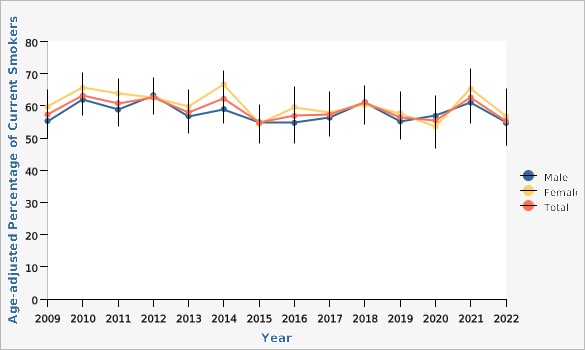
| Males vs. Females | Year | Age-adjusted Percentage of Current Smokers | Lower Limit | Upper Limit | ||
|---|---|---|---|---|---|---|
Record Count: 39 | ||||||
| Male | 2009 | 55.3% | 49.8% | 60.7% | ||
| Male | 2010 | 61.9% | 57.0% | 66.5% | ||
| Male | 2011 | 58.8% | 53.7% | 63.7% | ||
| Male | 2012 | 63.3% | 57.6% | 68.7% | ||
| Male | 2013 | 56.8% | 51.5% | 61.9% | ||
| Male | 2014 | 59.0% | 54.4% | 63.4% | ||
| Male | 2015 | 54.9% | 49.4% | 60.2% | ||
| Male | 2016 | 54.7% | 48.3% | 61.0% | ||
| Male | 2017 | 56.3% | 50.5% | 62.0% | ||
| Male | 2018 | 61.1% | 55.5% | 66.4% | ||
| Male | 2019 | 55.2% | 49.6% | 60.7% | ||
| Male | 2020 | 56.9% | 50.3% | 63.2% | ||
| Male | 2021 | 61.0% | 54.4% | 67.2% | ||
| Female | 2009 | 59.7% | 53.9% | 65.1% | ||
| Female | 2010 | 65.6% | 60.4% | 70.5% | ||
| Female | 2011 | 63.9% | 58.9% | 68.6% | ||
| Female | 2012 | 62.6% | 57.3% | 67.6% | ||
| Female | 2013 | 59.8% | 54.1% | 65.2% | ||
| Female | 2014 | 66.7% | 62.0% | 71.1% | ||
| Female | 2015 | 54.4% | 48.3% | 60.4% | ||
| Female | 2016 | 59.6% | 52.9% | 65.9% | ||
| Female | 2017 | 57.8% | 50.7% | 64.5% | ||
| Female | 2018 | 60.3% | 54.1% | 66.1% | ||
| Female | 2019 | 57.7% | 50.7% | 64.5% | ||
| Female | 2020 | 53.6% | 46.7% | 60.3% | ||
| Female | 2021 | 65.3% | 58.5% | 71.5% | ||
| Total | 2009 | 57.3% | 53.3% | 61.2% | ||
| Total | 2010 | 63.2% | 59.6% | 66.7% | ||
| Total | 2011 | 60.8% | 57.2% | 64.3% | ||
| Total | 2012 | 62.7% | 58.8% | 66.5% | ||
| Total | 2013 | 58.0% | 54.2% | 61.8% | ||
| Total | 2014 | 62.2% | 58.9% | 65.4% | ||
| Total | 2015 | 54.7% | 50.6% | 58.7% | ||
| Total | 2016 | 56.9% | 52.1% | 61.6% | ||
| Total | 2017 | 57.2% | 52.9% | 61.5% | ||
| Total | 2018 | 61.1% | 57.0% | 65.1% | ||
| Total | 2019 | 56.4% | 51.9% | 60.7% | ||
| Total | 2020 | 55.5% | 50.8% | 60.2% | ||
| Total | 2021 | 62.6% | 57.8% | 67.3% | ||
Data Notes
Age-adjusted to U.S. 2000 population.Data Source
The Utah Department of Health and Human Services Behavioral Risk Factor Surveillance System (BRFSS)References and Community Resources
Utah Department of Health, Tobacco Prevention and Control Program website: [http://www.tobaccofreeutah.org] Tobacco Free Resource Line: 1-877-220-3466 More information on the Behavioral Risk Factor Surveillance System is available at the website of the Centers for Disease Control and Prevention - [http://www.cdc.gov/brfss/] More information on changes to the BRFSS methodology can be found at [http://health.utah.gov/opha/OPHA_BRFSS.htm].More Resources and Links
Evidence-based community health improvement ideas and interventions may be found at the following sites:- Centers for Disease Control and Prevention (CDC) WONDER Database, a system for disseminating public health data and information.
- United States Census Bureau data dashboard.
- Utah healthy Places Index, evidence-based and peer-reviewed tool, supports efforts to prioritize equitable community investments, develop critical programs and policies across the state, and much more.
- County Health Rankings
- Kaiser Family Foundation's StateHealthFacts.org
- Medical literature can be queried at PubMed library.
Page Content Updated On 11/01/2022,
Published on 12/20/2022

